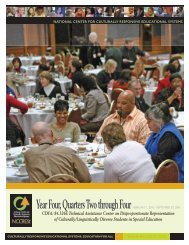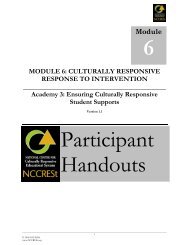Disproportionate Representation of Culturally and ... - NCCRESt
Disproportionate Representation of Culturally and ... - NCCRESt
Disproportionate Representation of Culturally and ... - NCCRESt
Create successful ePaper yourself
Turn your PDF publications into a flip-book with our unique Google optimized e-Paper software.
Guiding Questions<br />
What is the nature <strong>of</strong> disproportionate<br />
representation in our nation’s schools?<br />
What are parents’ legal rights for preventing<br />
inappropriate placement ?<br />
What are some resources <strong>and</strong> guidelines that<br />
parents <strong>and</strong> students can access to help prevent<br />
inappropriate placement?
Definition <strong>of</strong> Disproportionality<br />
“the extent to which membership in<br />
a given group affects the probability<br />
<strong>of</strong> being placed in a specific special<br />
education disability category”<br />
(Oswald, et al., 1999)
Disproportionality Calculation<br />
Although there is some variation in the calculation<br />
methods, the generally accepted measurement is a<br />
Relative Risk Ratio. This is calculated by comparing one<br />
ethnic group’s risk <strong>of</strong> being identified for a disability<br />
with that <strong>of</strong> a comparison group (either White<br />
students or all other students – we use White students<br />
in our calculations):<br />
# <strong>of</strong> students in X ethnic/racial group in Y disability category<br />
Total # <strong>of</strong> students in X ethnic/racial group in the school population<br />
_______________________________________________________<br />
# <strong>of</strong> White students in Y disability category<br />
Total # <strong>of</strong> White students in the school population
Happy Middle School<br />
1200 students<br />
10 ED<br />
400 White<br />
? ED<br />
400 Black<br />
? ED<br />
400 Latino
Context <strong>of</strong> Disproportionality<br />
• Disproportionality has been a concern for over three<br />
decades (Dunn, 1968; Johnson, 1969; Donovan & Cross,<br />
2002).<br />
• African American children 2.88 times more likely to be<br />
labeled MR <strong>and</strong> 1.92 times more likely to be labeled ED<br />
than white children (Donovan & Cross, 2002).<br />
• Native Americans twice as likely to be labeled ED or SLD<br />
(Donovan & Cross, 2002).<br />
• Although Latino students <strong>of</strong>ten not over-represented in<br />
national data, variability across states, districts, <strong>and</strong> subpopulations<br />
it is likely to change when their proportion <strong>of</strong> a<br />
district’s diverse student body increases (Donovan & Cross,<br />
2002; Losen & Orfield, 2002).
IDEA Regulation<br />
The State must have in effect, consistent with the<br />
purposes <strong>of</strong> 34 CFR Part 300 <strong>and</strong> with section 618(d)<br />
<strong>of</strong> the Act, policies <strong>and</strong> procedures designed to<br />
prevent the inappropriate overidentification or<br />
disproportionate representation by race <strong>and</strong> ethnicity<br />
<strong>of</strong> children as children with disabilities, including<br />
children with disabilities with a particular impairment<br />
described in 34 CFR 300.8 <strong>of</strong> the IDEA regulations.<br />
[34 CFR 300.173] [20 U.S.C. 1412(a)(24)]
In addition to identification information,<br />
the States must also collect <strong>and</strong> examine<br />
data with respect to:<br />
The placement in particular educational settings<br />
<strong>of</strong> these children; <strong>and</strong><br />
The incidence, duration, <strong>and</strong> type <strong>of</strong> disciplinary<br />
actions, including suspensions <strong>and</strong> expulsions.<br />
[34 CFR 300.646(a)] [20 U.S.C. 1418(d)(1)]
What counts as “disproportionate”?<br />
There is no federally-defined st<strong>and</strong>ard<br />
for the level at which risk becomes<br />
“disproportionate.”<br />
When reporting to the U.S. Department<br />
<strong>of</strong> Education, states’ acceptable risk ratio<br />
limits ranged from 0.25 to 0.33 for<br />
underrepresentation <strong>and</strong> 1.5 to 4 for<br />
overrepresentation.
10 ED<br />
400 White<br />
10 ED<br />
400 White<br />
40 ED<br />
400 Black<br />
10 ED<br />
400 White<br />
3 ED<br />
400 Latino<br />
10 ED<br />
400 White<br />
= .025/.025 = 1 Relative Risk Ratio<br />
= .10/.025 = 4 Relative Risk Ratio<br />
= .0075/.025 = 0.3 Relative Risk Ratio
Changing the vision…<br />
“Education is THE civil rights<br />
issue <strong>of</strong> our time.”<br />
(Arne Duncan, Secretary <strong>of</strong> Education 2008)
Important<br />
Difference<br />
Between IDEA<br />
<strong>and</strong> Section 504<br />
Office <strong>of</strong> Civil<br />
Rights<br />
Complaints
Resources for Parents<br />
• www.nccrest.org<br />
• www.urbanschools.org<br />
• www.niusileadscape.org<br />
• www.equityalliance@asu.edu<br />
• Parent Briefs<br />
• Assessment Tools<br />
• Equity Products<br />
• Data Maps
Parent Briefs<br />
Practitioner Briefs explain research <strong>and</strong> its application to<br />
specific practices, roles, or policies that impact<br />
disproportionality.
Equity Products<br />
• Power-Point Presentations from conferences,<br />
workshops, <strong>and</strong> online events <strong>of</strong>fer suggestions<br />
for addressing disproportionality.<br />
• State Pr<strong>of</strong>iles are research-based snapshots <strong>of</strong><br />
individual states’ efforts to address<br />
disproportionality.<br />
• On Points are written by a variety <strong>of</strong> researchers,<br />
practitioners <strong>and</strong> family members about specific<br />
practices that support inclusive schooling.
Moving Forward…
Guiding Questions<br />
What is the nature <strong>of</strong> disproportionate<br />
representation in our nation’s schools?<br />
What are parents’ legal rights for preventing<br />
inappropriate placement ?<br />
What are some resources <strong>and</strong> guidelines<br />
that parents <strong>and</strong> students can access to help<br />
prevent inappropriate placement?










